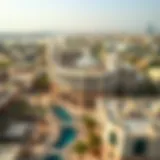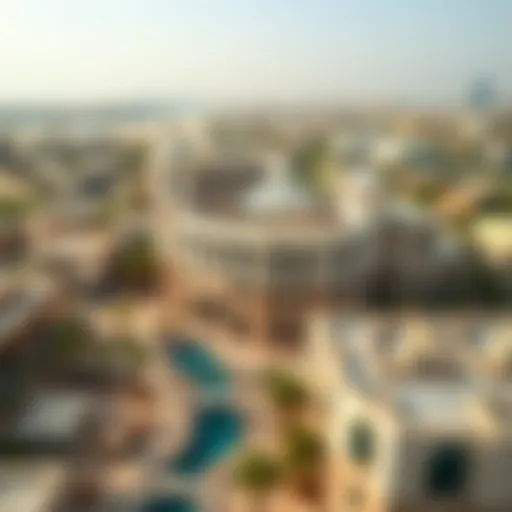Exploring the Green Metro Line in Dubai
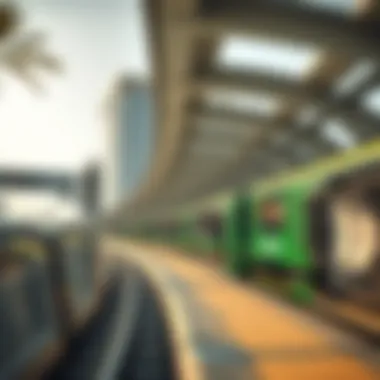

Intro
The Green Metro Line in Dubai has become more than just a mode of transportation; it's a lifeline connecting the various facets of urban life. As the city burgeons and evolves, understanding this metro line's significance offers a glimpse into the future of urban mobility in Dubai. With its interconnected nature, the Green Line is not just about getting from point A to B; it is about shaping neighborhoods, enhancing real estate prospects, and fostering a more sustainable urban environment.
As a primary public transport artery, the Green Metro Line serves several key areas, acting as a catalyst for development and investment. As you traverse its route, each station ties into vibrant communities, peppered with commercial spaces, parks, and residential options that cater to various demographics. Hence, grasping the operational nuances of this metro system becomes pivotal for anyone keen on navigating Dubai's dynamic real estate landscape.
Market Trends and Analysis
Current Market Conditions
The real estate market along the Green Metro Line is experiencing a transformative phase. Areas surrounding the metro stations have observed a steep uptick in property values. An interesting phenomenon is how accessibility translates to desirability; homes and commercial spaces situated near these transport hubs command a premium. According to numerous market surveys, properties in close vicinity to the Green Metro Line have reported value appreciation rates that surpass those in less accessible areas.
- Increased demand for residential units near metro stations
- Rising prices of commercial properties aligning with metro line expansions
- Shift in buyer preferences towards eco-friendly commuting options
With more residents shifting into urban settings for work and leisure, the demand for accessible, sustainable living solutions is skyrocketing. The local government is further spurring this trend by investing heavily in infrastructure projects and green initiatives that complement the metro system. The continued expansion plans for the Green Line highlight this urgency to connect more of the city and its burgeoning communities.
Future Predictions and Growth Areas
Looking forward, it's clear that the trajectory for the Green Metro Line indicates ongoing growth and viability. With projected metro expansions into previously underserved neighborhoods, we can expect increased property interest and higher investment returns. Notably, areas like Al Jaddaf and Ras Al Khor are singled out as potential hotspots, likely to benefit significantly from the enhancements to public transport.
The anticipated integration of gigabit broadband networks and smart city concepts around the metro line could further escalate these neighborhoods' allure. Investors and developers should keep a keen eye on these emerging trends, as the synergy between transportation and real estate continues to shape the urban landscape.
"Any urban property close to public transport is a golden nugget, especially in a city like Dubai where mobility is paramount."
By capitalizing on real-time trends and making informed decisions, stakeholders can maximize their chances of securing lucrative investments along the Green Metro Line. This insight equips everyone from real estate agents to expatriates with the information they need to navigate this evolving market atmosphere.
Prelims to the Green Metro Line
The Green Metro Line holds a crucial place in Dubai’s public transportation arsenal, enhancing urban mobility and shaping the city’s transit landscape. This line spans vital neighborhoods, connecting diverse communities while also serving as a catalyst for economic growth and sustainability. As the only line that runs predominantly through the older sections of the city, it intricately ties together both modern developments and traditional districts, catering to a variety of riders—from daily commuters to occasional tourists.
Benefits of the Green Metro Line
- Accessibility: By providing extensive coverage of key residential areas, the Green Line ensures that residents can easily access vital services, schools, and workplaces. Many local expatriates depend on this reliable transport option.
- Environmental Impact: This metro line, like other elements of the Dubai Metro system, promotes eco-friendliness by reducing reliance on personal vehicles. This shift plays a significant part in achieving sustainable urban development goals, an essential consideration for the city’s future.
- Economic Growth: The Green Line also plays a pivotal role in boosting local businesses. As foot traffic increases around the metro stations, consumers are drawn to shops and restaurants located conveniently near these stops. This increased patronage can significantly uplift local economies.
Moreover, it’s not just a transport solution; it represents the city’s forward-thinking approach to urban planning. Integrating the Green Metro Line with other forms of transport—trams, buses, and taxis—further enhances its functionality, ensuring that moving around Dubai is both seamless and efficient.
Riding the Green Line, passengers can observe the dynamic spectrum of life in Dubai, from the towering skyscrapers in Downtown to the traditional heritage of Deira and Bur Dubai. This glimpse into the city’s soul underlines the line’s importance, as it stitches together the fabric of diverse communities and cultures.
"In a city like Dubai, where distance can be daunting, the Green Metro Line transforms the way people navigate their daily lives, making urban space much more manageable."
In essence, the introduction of the Green Metro Line is not merely a technical achievement, but also a societal advancement, enhancing connectivity while reflecting Dubai’s growth. For real estate agents, investors, expatriates, homeowners, and developers, understanding this infrastructural gem is vital. It’s about recognizing how the metro influences property values, community dynamics, and everyday life in this vibrant metropolis.
Historical Context
The historical context of the Green Metro Line in Dubai provides invaluable insight into its significance within the broader framework of the city's infrastructure development. This section delves into the origins of the metro system, highlighting how it emerged as a response to Dubai's rapid urbanization and increasing population demands. The inception and subsequent growth of the metro not only revolutionize transportation in the emirate but also serve as a vital connector of communities, promoting the integration of various neighborhoods. Understanding this context is crucial for anyone looking to comprehend the factors that shaped the city’s contemporary landscape and investment opportunities.
Inception of the Metro System
The concept of a metro system in Dubai went from a distant dream to a pressing necessity in the late 1990s. With a bustling population that was steadily growing, traffic congestion began to strangle the city’s roads. Public transportation was limited, relying primarily on taxis and buses, which proved inadequate to meet the needs of the increasingly urbanized population. The Dubai government recognized that a modernized form of mass transit was needed to facilitate economic growth while easing the burden of traffic.
In 2005, His Highness Sheikh Mohammed bin Rashid Al Maktoum, the Vice President and Prime Minister of the UAE, initiated the Dubai Metro project, marking a decisive move towards modern mobility solutions. This ambitious undertaking was guided by the vision to develop a transport system that was not just efficient but also environmentally friendly. Notably, the metro was designed to accommodate the city's rapid expansion, laying the groundwork for a future that prioritized sustainable transit solutions. The groundbreaking shift towards a rail system illustrated Dubai's commitment to embracing innovative technologies for urban transit.
Development Timeline of the Green Line
The Green Metro Line’s development reflects a careful balance of planning and execution. Here’s a descending timeline that highlights the pivotal milestones along the way:
- 2005: Official announcement of the metro project, focusing on two main lines: the Red Line and the Green Line.
- 2006: Construction of the Green Line commenced, with the aim to serve key areas such as Deira and Bur Dubai.
- 2011: The Green Line was officially inaugurated, boasting its first segment with 11 Stations, significantly enhancing connectivity for commuters in densely populated neighborhoods.
- 2015: Further expansions were executed to enhance reach and improve overall passenger experience, bringing the total stations to 29.
- 2018: The metro system marked a significant milestone, achieving record daily ridership figures, showcasing its integral role in the daily lives of residents and expatriates.
This methodical approach to the metro’s development demonstrates the foresight of planners in anticipating the future needs of Dubai’s residents. The rapid construction and the responsive adjustments made throughout the timeline signify Dubai's adaptability and willingness to innovate. Moving forward, the Green Line’s continued expansion and integration with other transport modes will undoubtedly shape the advancements of public transportation in Dubai.
“A well-connected city is a thriving city. The Green Metro Line not only serves as a transport facility, but as a crucial artery for the heart of urban life in Dubai.”
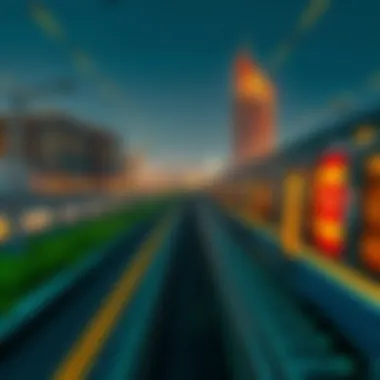

For further insights into Dubai's overall transportation infrastructure, you might explore resources on Dubai Metro, which detail the various components and ongoing enhancements of this vital system.
Technical Specifications
Understanding the technical specifications of the Green Metro Line is crucial for those interested in Dubai's public transportation framework. These specifications not only detail the physical parameters of the line but also underscore its operational efficiency and user comfort. Given the significance of this metro line in linking various neighborhoods and suburban areas, appreciating its design influences how well it fulfills the needs of current and future riders.
Line Length and Stations
The Green Metro Line stretches over a significant length, connecting key areas of the city. This line was designed with precision to meet the demands of a rapidly growing urban center. The total length of the Green Line is about 23 kilometers, comprising 11 stations. Some of its notable stops include:
- Dubai Healthcare City Station: This stop plays a pivotal role in providing access to hospitals and medical facilities in the region.
- Al Jaddaf Station: An important hub that services both residential and commercial areas.
- Dubai Gold Souk Station: A favorite for tourists and locals alike, this station provides a route to one of Dubai’s bustling marketplaces.
These stations are strategically placed, providing essential connectivity that caters to both residents and visitors. This is particularly valuable in a metropolitan area where ease of movement can significantly enhance day-to-day life.
Rolling Stock and Facilities
The Green Line is equipped with modern rolling stock designed to ensure safety and comfort for all passengers. The trains feature several advancements in technology, contributing to their efficiency and reliability. They are fully automated and driverless, with a design focused on minimizing energy consumption and maximizing passenger comfort. Moreover, facilities on the trains include:
- Air Conditioning: Essential for comfort given Dubai's extreme heat.
- Wide Doorways: Facilitating a smooth boarding process.
- Dedicated Spaces for Disabled Passengers: This ensures accessibility for everyone.
Such elements of design not only help in improving operational capability but also reflect a commitment to providing an inclusive public transport experience. As Dubai continues to grow, the importance of an efficient metro system cannot be overstated. With the rapid urbanization and influx of residents, the Green Metro Line stands out as an essential artery within the city’s infrastructure.
Investing in public metro systems like this guarantees that urban development can keep pace with population growth.
Ultimately, the Green Metro Line's technical specifications highlight the city's ambition to create a modern, efficient public transport milieu that enhances both mobility and quality of life.
Key Stops and Connections
The Green Metro Line is not merely a passage from point A to point B; it spins an intricate web connecting Dubai's vibrant tapestry of neighborhoods. The importance of understanding the key stops and their connections cannot be overstated, especially for those who are looking to navigate the city effectively. The metro line offers easy access to various attractions, residential areas, and business hubs, making it an invaluable asset for both residents and visitors.
Notable Stops on the Green Line
The Green Line has several stops that stand out. Each is significant not just for its location but also for what it offers to the community.
- Al Riqqa: A bustling area that showcases a mix of traditional and modern culture with abundant shopping and dining options. Its proximity to historic sites adds to its allure for tourists and locals alike.
- Union: This stop serves as a pivotal interchange point, connecting the Green Line with the Red Line. Here, commuters can easily switch lines to continue their journey around the city.
- Baniyas Square: Known for its historical significance, this area serves as a nexus for business and commerce, attracting both local and international investors.
- Al Ghubaiba: Close to the Dubai Museum and the historic Dubai Creek, this stop appeals to history buffs and sightseers. It's the gateway to some of Dubai's oldest neighborhoods.
- Dubai Health Care City: A beacon for medical tourism, this stop connects residents with the facilities in one of the emirate's major health hubs. This can be particularly beneficial for expatriates and families seeking medical care.
In all, these stops not only facilitate ease of transportation but also help in bolstering the economic and cultural landscape of Dubai.
Interchange with Other Lines
The Green Line's design emphasizes connectivity, particularly through its interchanges with other metro lines. This strategic planning reflects a more holistic vision of Dubai's urban mobility and transportation system.
- Union Station: The most significant interchange along the Green Line. Here, passengers can transition seamlessly to the Red Line, which extends from Rashidiya to UAE Exchange. This connection is crucial, as it links various neighborhoods, commercial centers, and popular attractions.
- BurJuman: Another vital point of change, linking the Green Line with the Red Line. With proximity to several shopping malls, this stop is always bustling with activity and offers additional convenience for commuters.
- Rashidiya: For those traveling on the Red Line, this station allows for easy access to the Green Line, facilitating a broader network of travel options.
"The Green Metro Line exemplifies how effective transportation can redefine urban life. Its network connects not just places, but people."
This line is integral for everyone, especially real estate agents, investors, and anyone eyeing opportunities in Dubai's dynamic market. The Green Metro Line isn't just an aspect of infrastructure; it's a vital part of the fabric that makes Dubai a living, breathing metropolis.
Impact on Urban Development
The development of the Green Metro Line is integral to the urban fabric of Dubai. This transit system doesn't merely connect points A to B; it acts as a catalyst for comprehensive urban growth. The metro’s influence extends beyond mere transportation, shaping neighborhoods and significantly altering the landscape of real estate opportunities in the vicinity.
Shaping Neighborhoods
The impact of the Green Metro Line on local neighborhoods cannot be overstated. For instance, stations like Al Jaddaf and Dubai Healthcare City have been pivotal in transforming their respective areas. These neighborhoods are evolving from quiet suburbs into vibrant hubs of activity. As metro access improves, so too does the appeal for businesses, which draws residents and visitors alike.
When we look at transportation developments globally, it’s clear that public transit—especially metro systems—enhances livability. A well-connected area often sees an influx of cafes, shops, and services, providing more community-focused environments. Residents find a pronounced sense of accessibility as they navigate their daily lives. In areas previously overlooked for their distance from central business districts, we start seeing urban renewal occur.
From parks to workplaces and cultural sites, the Green Line promotes multi-functional spaces. This holistic approach to neighborhood development cultivates a lifestyle where residents can live, work, and play—all in proximity to each other. Not to forget, the sustainability aspect is hard to ignore; areas are becoming more pedestrian-friendly, inviting strolls or bike rides, contributing positively to the community’s health and well-being.
Real Estate Trends Near Metro Stations
The advent of the Green Metro Line has led to notable shifts in real estate trends near its stations. Properties located within walking distance of metro stops are increasingly in demand. This demand translates into rising property values, compelling many investors to focus their attention on these burgeoning hotspots.
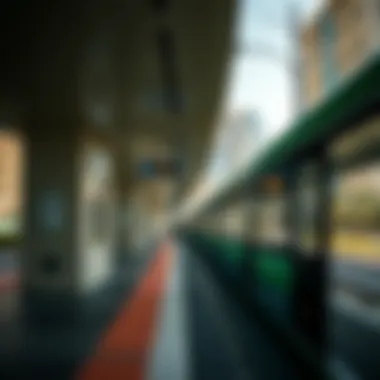

Current Trends Include:
- Rising Rental Prices: With easy access to public transport, rental rates near metro stations have climbed steadily, giving landlords the upper hand.
- New Developments: Property developers are racing to construct mixed-use projects near metro lines, aiming to capitalize on the influx of potential tenants who prefer convenient commutes.
- Investment Opportunities: For real estate investors, properties adjacent to metro stations present lucrative options. The trend indicates that properties in these areas can yield impressive returns.
"Proximity to public transport increases property values and is a sign of urban vitality." – Real Estate Analyst
A spotlight on notable stations reveals how new residential complexes, shopping centers, and business offices are reshaping real estate dynamics in Dubai. The Green Line is not just facilitating travel but is fundamentally reorienting the market, making some neighborhoods ripe for development. In essence, the interaction between the metro and real estate is a transformative force that signals growth, opportunity, and a shift towards sustainable urban living.
For more information on urban development and transport impact, check resources like Wikipedia and Britannica.
Urban mobility's evolution continues, encouraging a closer look at how infrastructure is setting the stage for the future of Dubai.
Environmental Considerations
The Green Metro Line in Dubai is more than just a mode of transport; it’s a testament to the city’s commitment towards creating a more sustainable environment. As urban areas continue to expand, the strain on existing infrastructures mounts, making it crucial to factor environmental considerations into city planning. Just like a well-oiled machine, the Green Metro operates, contributing not only to urban mobility but also to greener city initiatives.
Sustainability Initiatives
Dubai’s Green Metro Line boasts a number of sustainability initiatives that set it apart from conventional transport systems. It integrates energy-efficient technologies and environmentally friendly practices which significantly reduce the ecological impact of urban transport. A notable aspect is the use of solar panels at various stations. By harnessing the sun's energy, these panels help power operations, cutting down the demand for electricity from fossil fuels.
Furthermore, the construction materials used during the line's development prioritize recyclability and low carbon outputs. This conscious choice reflects a broader ambition to minimize waste and promote eco-friendly practices. Stations are designed with natural lighting and ventilation in mind, which enhances energy efficiency.
Rider Experience
The rider experience on the Green Metro Line in Dubai shapes not just how people move about the city but also contributes significantly to their overall perception of public transportation. It's all about creating an environment where commuting is both enjoyable and efficient. Everything from the station layout to the train's interior design affects how passengers interact with the Metro system and each other. Providing comfort, ease of access, and a sense of security plays a crucial role in encouraging more residents and visitors to utilize public transport.
Facilities for Passengers
Passenger facilities on the Green Metro Line are designed to cater to diverse needs, making travel more accessible. Most stations are equipped with lifts and ramps, catering to those with mobility challenges. Benches for resting, clear signage for navigation, and real-time information displays help passengers feel informed and at ease.
- Waiting Areas: Each platform has waiting areas that are spacious and well-ventilated, providing a pleasant atmosphere for riders.
- Wi-Fi Access: There’s complimentary Wi-Fi available in many stations, allowing commuters to catch up on work or relax online while waiting.
- Restrooms: Clean and accessible bathroom facilities in stations ensure a comfortable experience for all users.
- Retail Outlets: Some stations host convenience stores and kiosks, offering refreshments and essentials, making it easy for passengers to grab a bite before or after their journey.
These facilities are not merely about physical comfort; they contribute to a broader sense of community and connection among riders. The intent is to make every journey on the Green Line a seamless experience.
Safety and Security Measures
Safety and security on the Green Metro Line is paramount. The integrated approach of combining advanced technology with vigilant personnel fosters a secure environment for all passengers. Riders can truly feel at ease, knowing that their well-being is taken seriously.
Some notable safety measures include:
- CCTV Surveillance: Each station and train car is equipped with high-resolution cameras, ensuring real-time monitoring of all activities.
- Emergency Protocols: Staff undergoes regular training to handle emergencies. There are clear emergency exits and signage throughout the stations.
- Security Personnel: Trained security personnel patrol the stations and trains, ready to provide assistance whenever needed. Their presence significantly boosts passenger confidence.
- Incident Report System: An efficient feedback mechanism allows passengers to report any security concerns, contributing to a safer overall experience.
"Safety is not a gadget but a state of mind." This quote echoes the ethos surrounding the Green Metro, emphasizing that the feeling of safety can often be as important as the actual measures in place.
In summary, the rider experience on the Green Metro Line in Dubai fuses comfort, accessibility, and safety into a cohesive whole. This enhances the attractiveness of public transit as a means of moving across the city, ultimately shaping how urban life is navigated and understood.
Economic Contributions
The Green Metro Line in Dubai transcends mere transportation; it is a catalyst for economic enhancement. Understanding its economic contributions unveils how this transit system not only connects neighborhoods but also propels local commerce and investment opportunities, shaping the vibrancy of the metropolis. As Dubai pushes towards becoming a global hub for trade and tourism, the metro line plays a pivotal role by facilitating mobility and accessibility that are crucial for both businesses and residents.
Boosting Local Business
When we talk about the Green Metro Line, we cannot overlook its magnetic pull on local businesses. Businesses, especially retail operations, strategically position themselves around metro stations to capitalize on the foot traffic that such transport options bring. More pedestrians mean more customers, fostering a thriving economic environment.
In areas near the metro stops, we’ve seen a rise in cafes, boutiques, and service providers tapping into this influx of people looking to shop or eat after disembarking. It's a classic case of "location, location, location". Here are some specific ways the metro boosts local enterprises:
- Increased Visibility: Stations act as marketing hotspots for small businesses.
- Enhanced Access: Easy access means more potential customers, boosting sales.
- Business Collaborations: Local businesses near the metro line often collaborate for joint promotions or events, enriching the community spirit.
In essence, businesses that embrace their proximity to the Green Metro are reaping tangible benefits.
Investment Opportunities Linked to the Green Line
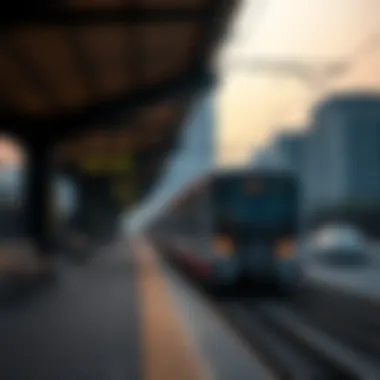

The Green Metro Line also opens up a wealth of investment opportunities, particularly in real estate. Investors are increasingly keen on properties close to metro stations due to the projected continuous growth in demand. A crucial factor is the anticipated appreciation in property values linked to accessibility.
Moreover, as neighborhoods mature with the addition of new amenities like parks, shopping centers, and schools, the real estate landscape transforms:
- Development Projects: Companies are actively seeking lands for development, knowing that being close to the metro means quicker returns on investment.
- Commercial Spaces: Developers are rushing to build office spaces and commercial hubs adjacent to the metro stations, tapping into the promising market.
- Sustainable Growth: The emphasis on public transport aligns with global sustainability goals, attracting investors who are conscious of green initiatives.
Investing in real estate near the Green Metro Line not only represents profitable ventures but also contributes to the overall improvement of Dubai's urban landscape.
Challenges and Limitations
When considering the Green Metro Line in Dubai, it’s essential to recognize the challenges and limitations it faces. Addressing these factors isn’t just about pointing out problems; it’s about understanding the nuances that come with operating such a vast urban transportation system. Analyzing these constraints provides critical insights into how the metro can evolve and better serve its growing user base. Factors such as operational constraints and future expansion needs are pivotal in assessing not only the current functionality but also the long-term sustainability of the metro network.
Operational Constraints
Operational constraints can present significant hurdles for the Green Metro Line. One primary challenge is the alignment of service frequency with the demand. For instance, during peak hours, stations can become crowded, leading to a less than optimal rider experience. Long wait times can deter potential commuters, which ultimately affects overall ridership numbers.
Additionally, maintenance and upgrades play a crucial role in operations. The need for periodic maintenance can lead to temporary line closures or reduced service hours. While essential for ensuring safety and reliability, these interruptions can frustrate regular passengers. It's imperative to balance the necessity of maintenance work with the demand for uninterrupted service.
Another challenge is the integration of technology. As rider expectations evolve with advancements in digital solutions, the metro must keep up. Older signaling systems can limit the number of trains that run simultaneously, causing delays. Implementing newer technologies without disrupting regular services is a puzzle that the metro authorities continuously face.
Future Expansion Needs
Looking forward, the future expansion needs of the Green Metro Line present both excitement and complexity. With Dubai’s rapid growth, it's crucial that the metro keeps pace with urban development. New neighborhoods popping up, like Dubai Creek Harbour and the developments surrounding Expo 2020, necessitate a metro system that stretches its reach further.
However, planning an expansion requires meticulous attention to various factors. Environmental impact assessments must be conducted to ensure that new lines do not disrupt local ecosystems. Community engagement is equally important; the perspectives of residents and businesses near proposed stations must influence planning decisions to foster local support.
Moreover, budget constraints can limit how far and how fast the Green Metro can grow. Funds earmarked for expansion can often fall short due to rising costs or competing priorities in the city's development agenda.
In summary, while the challenges and limitations faced by the Green Metro Line may seem daunting, they also provide an opportunity for growth and innovation. By addressing operational constraints and planning for future expansion holistically, the metro can continue to be the lifeblood of Dubai’s transit landscape, adapting seamlessly to the city’s dynamic needs and helping steer the urban mobility toward a more sustainable future.
"A robust transportation system not only connects people but also weaves the very fabric of the city, making it essential to address the challenges head-on."
For more detailed information on public transport developments, visit Wikipedia’s transportation section or Britannica.
Future Prospects
The future prospects of the Green Metro Line in Dubai hold significant importance as they reflect a broader vision for urban development and public transportation evolution. With increasing population density and the pressures of urbanization, the need for efficient transit solutions that are capable of adapting to the changing dynamics of the city is more critical than ever. Further expansion and enhancements to this metro line can foster a more interconnected urban environment, streamline the daily commutes of residents, and attract investments to key areas around the stops.
By developing a robust network of public transport, Dubai can aim for reduced congestion, shorter travel times, and enhanced quality of life for its inhabitants. Key prospects involve technological advancements, sustainability initiatives, and strategic partnerships that will redefine how citizens navigate the city.
Anticipated Developments in the Metro System
Looking ahead, several anticipated developments within the metro system portend promising changes. The authorities have laid out ambitious plans for extension and modernization that go hand-in-hand with Dubai's vision for the future.
- Line Extensions: Plans for extending the Green Line to cover areas that are currently underserved are underway. Connections to new emerging districts, such as Dubai Creek Harbor, are expected to enhance accessibility and encourage economic activity in these areas.
- Smart Technology Integration: The integration of smart technologies will provide greater efficiency in operations. This includes real-time tracking, automated fare collection, and better communication systems. For instance, mobile apps may provide riders with timely updates on train arrivals and delays, improving overall commuting experience.
- Enhanced Station Amenities: Anticipated developments also include refurbishing existing stations and adding new ones with enhanced amenities. Facilities like more spacious waiting areas, dedicated business lounges, and retail options could evolve the metro into a multi-dimensional space that caters to everyday needs.
- Sustainability Initiatives: The incorporation of eco-friendly technologies, such as solar power and energy-efficient systems, will help in reducing the carbon footprint of the transit system. Sustainability will be a central theme in the future design and operation of the metro.
Long-term Vision for Urban Mobility
As Dubai continues to grow, the long-term vision for urban mobility must not only accommodate the current demands but also anticipate future challenges. A well-designed transportation network is critical in promoting inclusivity and ensuring that all areas of the city are within reach.
- Multi-Modal Transport Integration: The future will likely see an enhanced integration between different transport modes, including buses, taxis, and cycling networks. A seamless transition between these modes will reduce travel times and increase the likelihood of public transit use.
- Focus on Affordability and Accessibility: Ensuring that public transport remains affordable and accessible for everyone will be a priority. This is crucial in catering to diverse demographics, particularly for low-income residents who rely heavily on public transportation.
- Promoting Active Transportation: Encouraging the use of bicycles and walking as viable transport options will help create a more livable urban environment. With the right infrastructure in place, residents can have safer, more enjoyable options for short-distance travel.
- Community Involvement in Planning: Engaging local communities in transport planning will facilitate better alignment of the transport provisions with the actual needs of residents. Public forums and feedback mechanisms could play a vital role in this process.
"The success of any transit system lies in its ability to adapt and serve the evolving needs of its community."
Through these developments, the Green Line and wider metro system can enhance mobility, improve connectivity, and support sustainable growth in Dubai. Investors and stakeholders with an interest in the emirate's future will find ample opportunities to engage as the city marches toward a comprehensive transportation model.
End
The Green Metro Line plays a pivotal role in Dubai's urban landscape, transforming how residents, expatriates, and investors navigate the city. This system not only serves commuters but also reshapes neighborhoods, enhances real estate values, and contributes positively to the environment. The interconnectedness it promotes among various regions cannot be understated, making it a backbone for urban mobility.
Key Takeaways of the Green Metro Line's Impact:
- Efficiency: The Metro supports efficient movement across the city, allowing for quicker access to work and leisure.
- Real Estate Surge: Areas near stations often witness a rise in property values, making it attractive for investors keen on a lucrative return.
- Sustainable Travel: By encouraging public transport usage, it helps in reducing individual carbon footprints, aligning with global sustainability goals.
"Public transportation is not just a service; it’s a lifeline connecting neighborhoods and communities."
The future of Dubai's Green Metro Line looks bright. As the city continues to expand, so too will the metro's capacity and connectivity. For real estate agents and developers, understanding these dynamics offers strategic advantages in positioning properties for the evolving market. Furthermore, for expatriates and homeowners, the metro contributes significantly to lifestyle enhancements – commuting becomes more manageable and less stressful.
In closing, the Green Metro Line stands as a testament to Dubai's commitment to sustainable urban growth. It not only facilitates daily commutes but also symbolizes a vision for a more integrated, environmentally conscious cityscape. For investors and locals alike, the Metro represents more than transportation; it’s a beacon of opportunity in the ever-evolving Dubai real estate market.






